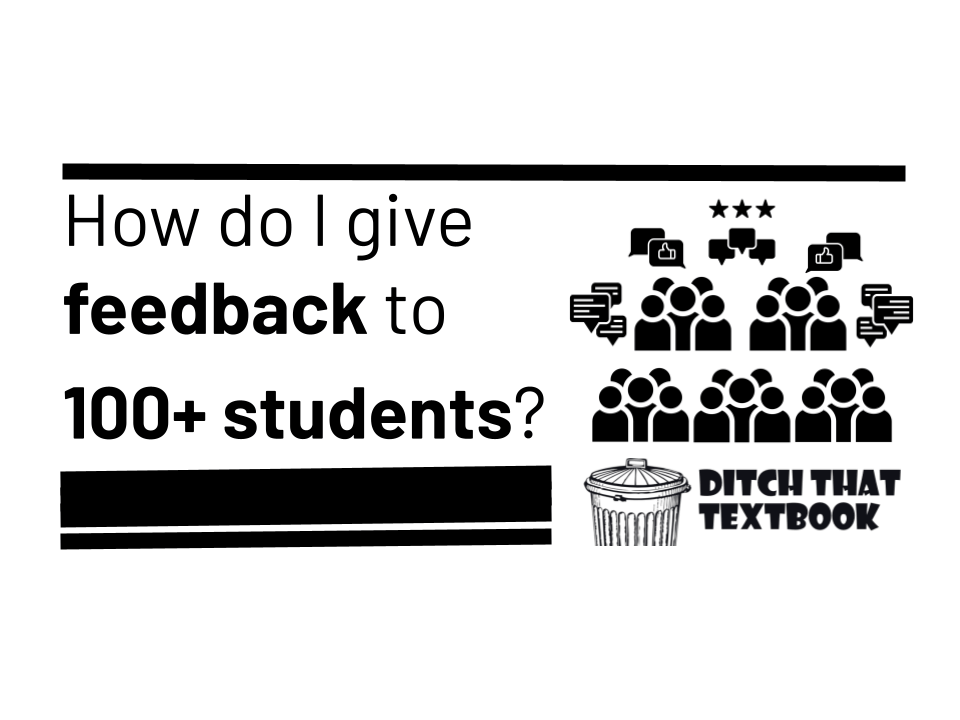
Purposeful, efficient, effective instruction. That's the holy grail of our work as teachers.
We teach. Then, we assess what we taught. Then, we reflect and make decisions on our instruction going forward.
Whether it's whole class, small group, or one-on-one instruction, our job as teachers is in a constant state of reflection and growth.
That's what makes it exciting but it also makes it an incredibly overwhelming and daunting task. Especially when we teach multiple classes of 30+ students. How do we modify our instructions to meet ALL of their needs? How do we make the most of our time and theirs?
That's what we want to tackle with you.
As part of the EfficienTEACH project, we are looking at assessment and the feedback we can provide in the most manageable, effective and efficient way possible.
TABLE OF CONTENTS (click to navigate)
Big picture feedback for the whole class

What is big-picture feedback for the whole class?
With any sort of student work, you can look at all of it as a whole to see patterns. Tendencies. It could be mistakes or misinterpretations that everyone is making. It could even be something positive -- where the whole class is doing something really, really well!
If you see a pattern across all of the students in your class, there's NO need to write the same comment in the student work over and over and over again. (Unless you have a really good reason to.)
Instead, share feedback on those whole-class tendencies with the whole class. This means that you provide the feedback once -- instead of once per student -- saving you time.
Ways to provide big-picture feedback to the whole class ...

Whole-group instruction -- Yep. Just stand up face to face in front of a group of human students. Tell them what you need to tell them. Show them what you need to show them. This may be the fastest, most low-prep way to do this. It does have some drawbacks from the items below (i.e. you can't rewatch or re-read what was said unless it was recorded), but you can decide if it's worth it.

Recorded instructional videos -- Record a video to give the whole-group feedback. Sometimes, a recorded video is a more efficient/effective way of demonstrating something because you can edit out dead space. Also, sometimes, the demo is clearer the way you create the video than it would be in person.
You can record these videos through a screen recording tool like Screencastify or Loom. You can use Flip (formerly Flipgrid) to record with your camera and/or show your screen (plus, with Flip, you can add images and do split screen).
To deliver them to students, you could put them in your learning management system (LMS) or wherever you share links with students. Or it could make sense to show the video in class. If the video

Use data from a review game -- Games like Kahoot! aren't just there for repetitions and because we like the funny gameplay music. They give us data that can drive meaningful feedback to students. If you play Kahoot!, it delivers instant data right after each question. That way, you can provide the most immediate whole-class feedback possible. With Quizizz, Gimkit, and other games where students answer questions at their own speed, you won't get that data until after the game. That's still very timely for providing targeted whole-class feedback. Learn more Powerful analytics in new, free Kahoot! reports take formative assessment to the next level.

Next-level whole class feedback: The Fast and the Curious EduProtocol -- This is one of my favorites for getting students repetitions and feedback for low critical thinking items you just reps to memorize. (i.e. vocabulary terms, states and capitals, periodic table of elements abbreviations, etc.) Give students several new terms you haven't taught them yet and let them do a Quizizz game or a Socrative quiz with them. Give them feedback on the ones they miss. Then let them take the game/quiz again. On subsequent days, if they get to a 95 percent class score, give them an A in the grade book for that activity and move on. Get more details in this blog post, or check out the video below.
Triaged individual feedback

What is triaged individual feedback?
The idea of triage is one that you'll see in hospitals when there's a catastrophic event.
When the emergency room has more patients than it can handle at once, they'll do an initial patient assessment to determine the severity of their injuries. They'll treat the most life-threatening injuries first and work their way down to the least severe.
Sometimes, student work has more points of feedback that we, as teachers, want to give students than they can really truly digest. Sure, we feel this burning desire to mark all of the comma splices and the verb conjugation errors and the failures to carry the one. But if a student sees a page that's dripping in red ink (or the digital equivalent), it might be overwhelming and they might not read anything. Or it might discourage them and do more harm than good.
Triaged individual feedback can help. Instead of marking everything, scan the student's work and pick out one thing (or two things or three things, depending on the activity, the student, and the length of the assignment). Give the student some actionable feedback on the focus points. Then, leave the rest of the feedback for another day.
Are we forsaking the student and their growth by doing this? Quite the opposite. We're empowering the student to improve on one or two things instead of overwhelming them with more things than they can internalize.
Ways to triage individual feedback

Scan, choose, and write -- This is the simple, low-prep, low-tech option. The concept is really basic. Scan the student's work. Find the couple things you want the student to focus on. Write some feedback -- including an action point on what the student can do differently next time.

Revise student work with screencasts -- Sometimes, we can explain what we mean to say better and faster through talking ... rather than writing. Instead of writing feedback on a student's digital work with digital comments, use a screen recording tool like Screencastify or Loom. Share your screen and hit record. Then tell the student what you need to tell them. End the recording and provide a link to the student. It might just save you time, and the student can hear it in your voice -- with your own intonation.
Student self-provided feedback

What is student self-provided feedback?
If the student only gets feedback from the teacher, the teacher becomes the bottleneck.
We teachers can only grade so many papers, write so many comments, provide so much feedback. No matter how many students you have, there will always be more of them than there are of us.
And it can push us to our breaking point.
Plus, isn't it better to help students to become self-sufficient? To help them to learn how to evaluate themselves and their work, to improve it, and to judge the results? When you do that, your classroom becomes more student-centered (and less teacher-centered). They don't need us as much to get the job done.
And that's the point.
Ways to encourage student self-provided feedback

Simple checklists -- These are less evaluative and more "yes/no." What are the basics that students need to have on a certain task? Make a checklist of the things you'd look for. Then give it to the student. They might not catch everything you would, but it's a good first line of defense before it gets to you.

Self assessment rubrics -- This is the more evaluative cousin of the simple checklist. Instead of just "do you have it?", a self-assessment rubric gives students some criteria for judging how well they've done their work. Instead of using it to provide a grade after the fact, students can use the rubric to evaluate their work after they've done it -- or evaluate it while they're doing the work in the first place.

Top 3 review -- As a teacher, you start to see common struggles that students have with your content and your tasks. They're those "pain points" ... the things that everyone seems to struggle with. Pick a few of those pain points. (Maybe three of them? That's where this "top 3" idea comes from.) Front-load students with some of these pain points. Provide some instruction, explanation, re-teaching, etc. through a written document, a video, a set of screenshots, etc. Once you've done this for one class, you have a set of assets you can provide students year after year that you don't have to re-create.

3-2-1 self reflection -- We often use 3-2-1 as an exit ticket for class and it works well to reflect on a lesson, day or even an entire unit. We can use that same protocol to encourage student self reflection too. Using this idea students will identify (three things they did well, two concepts they need to practice more, and ask 1 question of their teacher. You can modify this 3-2-1 reflection template to fit your class or use it as it.
Peer Feedback

What it is peer feedback?
As teachers, we strive to provide our students with quality feedback on their work. Getting feedback from their teacher is useful but getting feedback from their peers can be even more powerful. With peer feedback students provide feedback to one another using a protocol, sentence frames, or rubric. It's powerful because their audience has gone beyond the teacher and students get a chance to see the work that their classmates are producing as well their own.
Does this take trust and a community built on relationships? Of course, but if you can get your students to be able to give each other constructive feedback you'll not only be providing them with a lifeskill you'll also be saving yourself a lot of time.
Ways to encourage peer feedback

Two stars and a wish -- A protocol like “two stars and a wish” can be an effective tool for supporting students as they work on giving constructive feedback to their classmates. It works like this. As they are reviewing their classmates work they find two things they like about it (stars) and one thing they want them to fix/change (wish). It's simple but can be used with any grade level. You can make a copy of this Two Stars and a Wish form along with sentence frames here.

TAG Method -- In the TAG method students will "Tell something good", "Ask a question" then "Give a suggestion". It's similar to "two stars and a wish" but with the addition of asking a question. It scaffolded enough to provide some guidelines but provides the student with ample opportunity to give constructive and personalized feedback. Check out this TAG Feedback template which can be printed or used digitally.

Sentence starters & shout outs -- Sometimes you want students to give each other feedback quickly on something they just finished working on or are in the middle of working on. An easy way to do this is to have some sentence starters accessible and ready along with some simple shout out notes printed and ready to use.


Thanks for sharing
Thank you for the information! There are so many great tips and resources for all of us, regardless of our time in the classroom, through Ditch that Textbook.
Zenith article with candid information.
I really appreciate the perspective of triaged feedback! Often times when looking at students’ drafts of writing assignments I can get so caught up in spotting all of the mistakes that I end up not spending enough time with the other students in my class.
Setting up “triage” and looking for one or two focus areas will allow me to give more manageable bits of feedback to more (or all) students daily instead of not getting to speak to some students until they are nearly done with their paper and need to go back and do massive editing.
I am a teacher and this is so informative.
Thanks to this, I have started using more self-provided feedback in my classes. It’s amazing how much students are willing to critique themselves and often score themselves even lower than I would have when I ask, “What would you grade yourself on this assignment and why.”
Definitely an eye catcher!
Great entry!